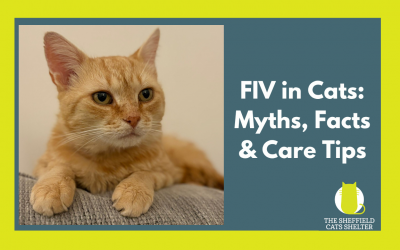As the temperatures rise in summer, we all look for ways to stay cool, and that includes our feline friends. Unlike humans, cats can’t sweat to cool themselves down, which makes them especially vulnerable to heat-related illnesses. One of the most serious threats is heatstroke, a potentially fatal condition that can affect even indoor cats.
At The Sheffield Cats Shelter, we want to help pet owners recognise the warning signs, prevent heatstroke, and act quickly if the worst happens.
Understanding Heatstroke in Cats
What is heatstroke?
Heatstroke occurs when a cat’s body temperature rises above 39.5°C (103.1°F) and they cannot cool themselves down. If left untreated, it can lead to organ failure and death.
What causes heatstroke in pets?
It doesn’t always have to be ‘hot’ for an animal to develop heatstroke. Exercising excessively in warm weather or being left in a warm or humid environment that is poorly ventilated can cause animals to quickly overheat. Avoidance is always best, but it’s important to know the signs of heatstroke so that you can treat your pet appropriately and know when to seek veterinary attention should they be unfortunate enough to suffer from it.
Important facts
- Normal cat body temperature: 38.1°C to 39.2°C (100.5°F to 102.5°F)
- Heatstroke begins around 40°C+ (104°F)
- A study from the Journal of Feline Medicine and Surgery found that 1 in 4 cats with severe heatstroke do not survive, underlining the urgency of early intervention.
Signs of Heatstroke in Cats
Cats are masters at hiding discomfort, so it’s vital to watch closely for any of these warning signs:
Early signs of heatstroke in cats
- Panting, this can progress to distressed or noisy breathing as the heatstroke worsens
- Restlessness or agitation, pacing, seeking shade or water
- Drooling
- Red gums or tongue
- Increased heart rate
- Vomiting or diarrhoea
Advanced stages of heatstroke in cats
This can include:
- Lethargy
- Confusion
- Weakness or collapse
- Seizures
First aid for heatstroke in cats – tips for owners
If you are concerned that your cat is overheating, you should act immediately, as heatstroke can rapidly become a life-threatening emergency.
- Take your cat somewhere cool, ideally a well-ventilated area or use a fan
- Offer them small sips of water (do not force them to drink)
- Cool them down by pouring small amounts of cool, lukewarm water on them. It’s important not to use cold water as this can reduce blood flow to the skin, reducing their ability to cool down
- Alternatively, drape a cool, wet towel over them. This should be changed every five minutes as it will no longer be effective once it warms up.
Once you’ve started these steps, call your vets, who will be able to advise you further. Even if your pet seems to be ok, it’s important to have them checked (unless told otherwise), as the more serious signs of heatstroke may not be immediately apparent.
Your vet will examine your cat and carry out a full assessment, including a temperature check. If they are concerned that your pet is suffering from heatstroke, they may advise that they be admitted for tests, supportive treatment, or observation until the signs of heatstroke have resolved. Early recognition and prompt initiation of these measures can help reduce the risks of any serious consequences, but avoidance is always best.
Tips for preventing heat stroke in cats
You can help to keep your cat cool and comfortable in summer by:
- Make sure your cat always has access to a cool, shaded area, both indoors and outside
- Restrict exercise on a warm day
- Remember, hot pavements can burn paws! If it’s too hot for your hand, it’s too hot for your cat to walk on
- Never leave a cat in a car or a hot room (eg conservatories)
- Ensure your cat always has drinking water available, and adding ice can help keep it cool
- Ensure your cat is regularly groomed
Heatstroke can strike quickly and is a genuine summer danger for cats. But with vigilance, preparation, and quick action, it can be prevented or treated in time. At The Sheffield Cats Shelter, we’re committed to the health and happiness of every cat. Please share this guide to help others protect their pets this summer—and if you ever have concerns about your cat’s wellbeing, always seek veterinary advice right away.
Stay cool, stay safe—and give your feline friend a shady spot to nap in!





